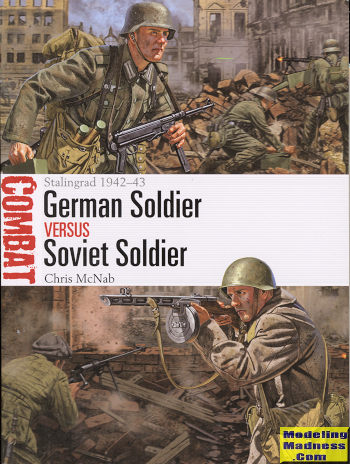 This is
one of Osprey's books in their Combat series. Like the duel series, it pits
contemporaries against each other. Generally there are three battles that show
how the course of events changes the combatants. In most editions, these combats
are separated by a period of time. Not so in this one.
This is
one of Osprey's books in their Combat series. Like the duel series, it pits
contemporaries against each other. Generally there are three battles that show
how the course of events changes the combatants. In most editions, these combats
are separated by a period of time. Not so in this one.
Each of the three examples is a continuation of events as the
fortunes of war change. What makes this edition somewhat unique is that it looks
at a chunk of time during the bitter struggle at Stalingrad in late 1942. Most
historians will point to Stalingrad as the event in the war in Russia that
finally stopped the German Army and began the long reversal of fortunes.
Indeed, by this time the German supply line was stretched and
as more territory was taken, the more tenuous that line became. The same can be
said for the German Army as they realistically could not totally occupy the
entire front line. Germany simply did not have the manpower. However, manpower
was one thing that the Soviets had, though it took time to get enough into place
to really make a major difference. The Soviets also had the vary major plus of
fighting on home turf.
However, Stalingrad was a different sort of battle. It
evolved into intense urban warfare where gains were measured in blocks or even
buildings. Neither side had trained for this and for the Germans, it was as much
a battle of combat engineers as anything else. Indeed, this book covers the
events of 13-14 October, when the combat engineers were paramount in the
conquest of a tractor factory and those of 11 and 13 November, when the Germans
were oh so close to completely pushing the Soviets off the west bank of the
Volga, but simply ran out of troops and time.
As is the norm in this series, we start with a look at the
opposing sides in terms of the strategic situation, the training of the troops,
their leadership and the equipment that they used. It then goes into the three
battles as mentioned earlier. This is followed by an analysis of events and to
see what either side learned. All easy stuff when working in hindsight, but not
so obvious to the parties involved at the time. The addition of superb art work,
maps and period photos truly enhances this edition and gives us just a small
taste of what it was like. A superb addition to this series and one that I know
you will find as fascinating a read as did I.
March 2019
For more on the complete line of Osprey books and to order
this one, visit
www.ospreypublishing.com
.
If you would like your product reviewed fairly and quickly, please contact
the editor or see other details in the Note to
Contributors.
 This is
one of Osprey's books in their Combat series. Like the duel series, it pits
contemporaries against each other. Generally there are three battles that show
how the course of events changes the combatants. In most editions, these combats
are separated by a period of time. Not so in this one.
This is
one of Osprey's books in their Combat series. Like the duel series, it pits
contemporaries against each other. Generally there are three battles that show
how the course of events changes the combatants. In most editions, these combats
are separated by a period of time. Not so in this one.